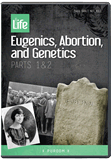
The Secondary Language That Leaves Evolutionists Speechless
Epigenetics
Researchers continue to unveil incredible complexities in a secondary DNA language, complicating efforts to explain life by evolution.
The standard modern evolutionary paradigm claims that random mutations in the DNA of an organism produce new beneficial traits that give it some advantage. The lucky creature then somehow outcompetes and reproduces itself more than all the others. This process somehow causes gradual changes over eons of time that magically change monkeys into people and dinosaurs into birds. At least that’s how the story goes, even though we don’t see creatures evolving into fundamentally new kinds of creatures today, and we do not see evidence of such transitions in the fossil record.
In total defiance of evolutionary predictions, scientists continue to find new discoveries that make their efforts harder. The information systems that regulate DNA, for instance, keep revealing amazing complexity. It’s impossible to imagine how evolution could randomly tinker with this integrated language system, let alone build it from scratch.
One of the most exciting and increasingly complex fields in the study of DNA is another control system, called epigenetics. This is a completely different language, outside DNA, which allows the organism to dynamically adapt and even change its physical appearance in some cases and then pass down these changes to offspring—within prescribed limits—without changing the DNA itself. In other words, organisms can adapt to their environment without evolving in the mythical Darwinian sense.
As scientists continue to improve their techniques for analyzing DNA, they are discovering that many differences once attributed to genetic mutations are really outside DNA, and the DNA hasn’t changed at all. This includes many classics of evolution, such as the “model” plant organism Arabidopsis, Darwin’s finches, and our cousins, the Neanderthals.
Another Layer of Complexity
The term epigenetics comes from the Greek word epi-, which means “on top of.” In other words, this is a highly specialized language system that overlays the DNA code. It’s a second language, which controls how genes are switched on or off. Although the epigenetic code does not involve a permanent and stable record of information like DNA, scientists are discovering that epigenetic changes can be passed along from parents to offspring for three to four generations.
Specialized cellular machinery reads, adds, or removes temporary modifications to the DNA string (called epigenetic tags). If these tags are not expertly monitored, placed, and controlled, serious health problems can result. In fact, many human diseases have now been shown to be associated with faulty epigenetic changes.
Epigenetics is so overwhelmingly complex that scientists are still trying to sort out how it works. For example, studying DNA involves just four different nucleotide letters (A, C, T, and G), but the modification code that controls the folding and reading of DNA (one aspect of epigenetics called the histone code) has over 100 different letters (chemical tags) in its alphabet.
The majority of evolutionary biologists never predicted such a complex layer of outside information controlling the DNA code.
The majority of evolutionary biologists never predicted such a complex layer of outside information controlling the DNA code to regulate how organisms respond to environmental cues (such as temperature, light, and food). This finding confuses the already muddy narrative of neo-Darwinian evolution. The rest of this article will examine three specific examples.
1. Plant Epigenetics Labeled “Evolution Heresy”
In 2013, scientists discovered that inherited trait variability in plants adapting to different environments had nothing to do with changes in DNA sequence, but instead was related to epigenetic modification of the DNA. This report went so contrary to evolutionists’ natural inclination that some were calling the research “evolution heresy.”1,2
The researchers tested different strains of the small weedlike mustard plant called Arabidopsis, considered the “model organism” for studying plant DNA. This common European plant has invaded the rest of the planet, including roadsides throughout the Americas and Australia. How does it adapt so well to different climates and soils?
Even though they were genetically similar, these plants can adapt how deeply their roots grow, when they flower, how their shoots grow, and their total size. They were even able to make quick changes in response to drought and nutrients, and pass down these changes to their posterity, without any change to their underlying DNA.
This is not a random mutational process in the DNA at all. First, these epigenetic tags are positioned at specific addresses in the DNA, and sophisticated molecular machines place the tags in response to specific environmental conditions. Second, information-detecting systems carefully interpret the DNA tags based on whether they are located in a root, leaf, or stem. (For instance, leaves are hard when the plant needs protection, but they become fleshier to hold water when conditions improve.) Third, passing along these tags to the next generation requires yet another complex and necessary system that copies the tags during cell replication.
2. Bird Icon Rooted in Epigenetics
The same kind of surprises have been found among birds. A 2013 study of house sparrows, introduced into Kenya in the 1950s, found that they have proliferated in many different environments around the country with the help of epigenetics. The birds don’t have any observable variation in the actual DNA sequence itself.3
Other researchers have looked at the finches in the Galápagos Islands, the poster children of evolution in action. For decades, biologists have studied the striking differences between the species of Darwin’s finches, especially the shape and size of their beaks that are adapted to different food sources (such as seeds, cactus tissue, and insects). What sort of mechanism underlies this adaptable variation in finch beaks?
Scientists have discovered that the genes are very similar among the various species.4,5 So what is controlling the variation in beaks? Researchers recently studied two different features of the genome. They discovered that epigenetics correlated closely with beak shape and size among species, while another genetic feature based on actual DNA sequences (called copy number variants or CNVs) did not.
In fact, the scientists also undertook a more targeted study of the epigenetic modifications of specific genes involved in the development and growth of beak shape, immune-system responses, and even the coloring of the birds. Yet again, the epigenetic modifications were different, but the gene DNA sequences were nearly identical for every species.
Later studies identified a population shift in two genes associated with beak size and shape, but epigenetic mechanisms clearly remain a major player in adaptation.6 If the DNA is not changing and shifting as dramatically as thought, but other systems produce much of this variability, then the lines have become very murky. Scientists are still trying to separate all these factors.
3. Epigenetics Mucks Up Human Evolution
Researchers have even turned their epigenetic guns toward “early humans,” such as Neanderthals. It turns out that the differences in anatomy, which first caused evolutionists to claim that Neanderthals were so different from us, are largely based on epigenetics.7,8
A 2014 research paper in the journal Science compared two Neanderthal individuals with modern humans and reported that greater than 99% of their DNA epigenetic profiles (the chemical tags on the DNA letter C) showed no significant differences compared to modern humans. The researchers did, however, find that the Neanderthals had major differences in tagged DNA regions associated with genes involved in the regulation of bone and skeletal development. These findings prompted the scientists to theorize that these particular epigenetic regulatory changes were involved in the various anatomical differences observed between modern humans and Neanderthals.
Sophisticated, Multilayered Designs to Adapt
Everywhere they look, researchers are finding new examples of epigenetic modifications that add or remove specialized chemical tags in an organism’s DNA structure without altering the genetic code. These modifications can produce adaptations without changing the DNA sequence. What’s even more incredible is that these alterations can be inherited over multiple generations.
Clearly, epigenetics is an important player in plant and animal adaptation without changing the DNA. The take-home message is that God put in place several layers of variability within created kinds so that creatures can “fill the earth” despite a changing climate and other conditions. However, these amazing created systems never allow for the molecules-to-man evolution proposed by evolutionists.
The complexity of DNA and its interacting languages speak of vast bioengineering, not purposeless, random evolutionary processes. It can only be attributed to the handiwork of an omnipotent Creator.
Answers Magazine
September–October 2019
The fact that the human race is divided into two biological groups, male and female, is unquestionable. So how is it possible that people question this distinction?
Browse Issue SubscribeFootnotes
- Elizabeth Pennisi, “Evolution Heresy? Epigenetics Underlies Heritable Plant Traits,” Science 341, no. 6150 (2013): 1055.
- Yuan-Ye Zhang et al., “Epigenetic Variation Creates Potential for Evolution of Plant Phenotypic Plasticity,” New Phytologist 197 (2013): 314–322.
- Andrea Liebl and Aaron W. Schrey, Christina L. Richards, and Lynn B. Martin, “Patterns of DNA Methylation Throughout a Range Expansion of an Introduced Songbird,” Integrative and Comparative Biology 53, no. 2 (2013): 351–358.
- Michael K. Skinner et al., “Epigenetics and the Evolution of Darwin’s Finches,” Genome Biology and Evolution 6, no. 8 (2014): 1972–1989.
- Richard Mallarino et al., “Closely Related Bird Species Demonstrate Flexibility Between Beak Morphology and Underlying Developmental Programs,” Proceedings of the National Academy of Sciences 109, no. 40 (2012): 16222–16227.
- Nala Roger, “Evolution of Darwin’s Finches Tracked at Genetic Level,” Nature (2016): https://doi.org/10.1038/nature.2016.19795.
- Jeffrey Tomkins, “Ancient Human DNA: Neandertals and Denisovans,” Acts & Facts 43, no. 3 (2014): 9.
- David Gokhman et al., “Reconstructing the DNA Methylation Maps of the Neandertal and the Denisovan,” Science (2014): doi.org/10.1126/ science.1250368.
Recommended Resources

Answers in Genesis is an apologetics ministry, dedicated to helping Christians defend their faith and proclaim the good news of Jesus Christ.
- Customer Service 800.778.3390
- © 2024 Answers in Genesis




